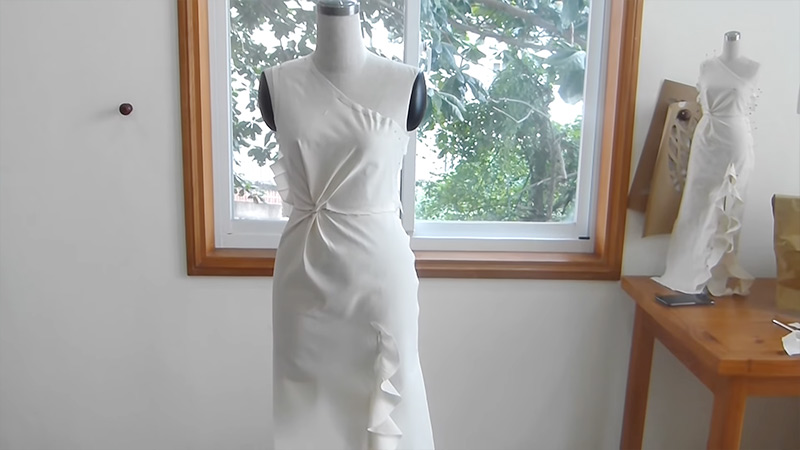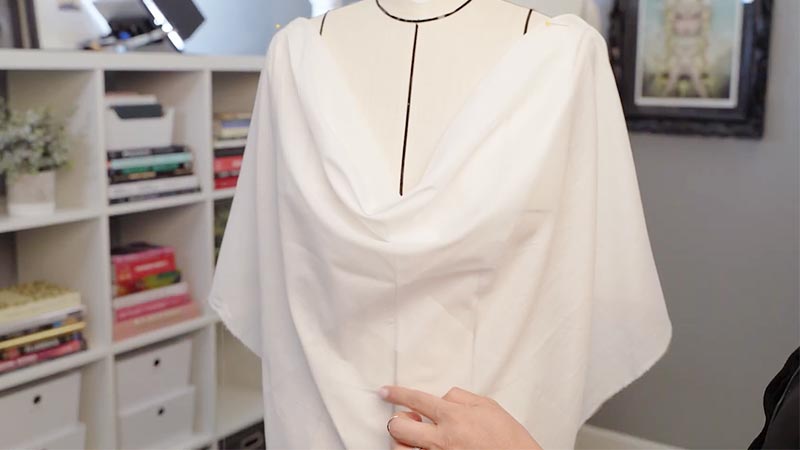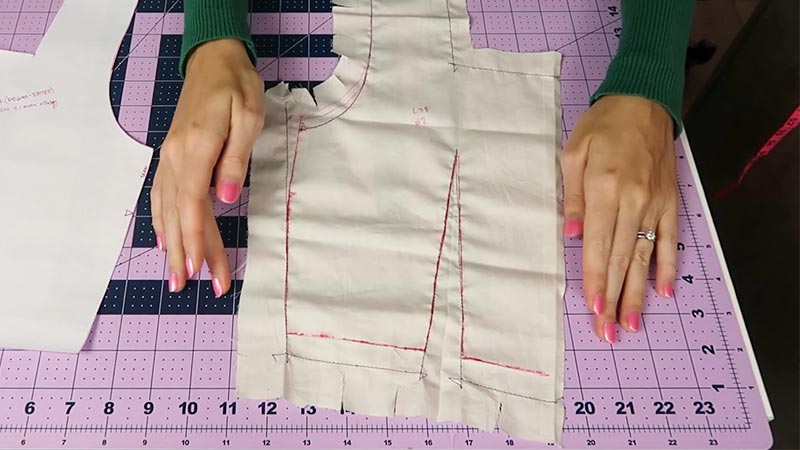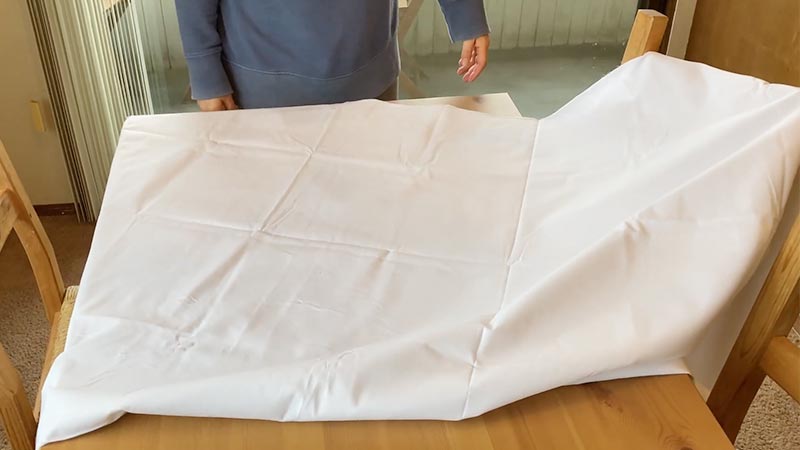In the world of sewing, “muslin” is a term that holds a special place. It refers to a versatile, cost-effective, and fundamental fabric used for various essential purposes in the sewing and fashion design processes.
Muslin is not just a type of fabric; it’s a tool that plays a pivotal role in creating prototypes, testing patterns, evaluating fit, and perfecting designs before working with more expensive materials.
Its affordability, neutrality, and ease of manipulation make it an indispensable asset for designers, tailors, and crafters.
Whether shaping a couture gown, refining a pattern, or crafting a household item, muslin serves as the foundation for creativity, precision, and cost-conscious production in the sewing world.

What Is A Muslin In Sewing?
In sewing, “muslin” refers to an inexpensive, unbleached, or minimally processed cotton fabric used for various purposes. It is primarily employed for pattern testing and prototype creation.
Designers and sewers use muslin to create trial garments (toiles) to evaluate fit, and pattern accuracy, and make necessary adjustments before cutting into more expensive fabrics.
It also serves as a neutral canvas for pattern development and is common in costume design and fashion sample creation.
Muslin can function as lining, interfacing, or backing fabric and is appreciated for its cost-effectiveness, ease of use, and unobtrusive appearance during the garment creation and testing process.
What Are the Key Characteristics of Muslin in Sewing?

The key characteristics of muslin in sewing play a vital role in its widespread use as a fundamental fabric for various applications. These characteristics are what make muslin a versatile and cost-effective tool for designers, sewers, and crafters alike:
Affordability
Muslin is a budget-friendly fabric, making it ideal for creating test garments, and prototypes, and for pattern development. Its cost-effectiveness helps designers and sewers avoid wasting expensive fabrics during the design and fitting process.
Neutrality
Muslin is typically available in plain, neutral colors, such as unbleached or white. Its neutrality ensures that it doesn’t interfere with the evaluation of fit, pattern, or design details, allowing for a clear assessment.
Versatility
Muslin is exceptionally versatile. Its various types can mimic the drape, weight, and behavior of different fabrics. This adaptability allows it to closely replicate the properties of the final fabric intended for a project.
Lightweight
Most muslin fabrics are lightweight, making them easy to handle and sew. This is especially valuable when creating test garments and prototypes that require precise sewing.
Breathability
Muslin is a breathable fabric, contributing to the comfort of test garments and underlinings. It is comfortable to wear and work with, even in warmer climates.
Ease of Sewing
Muslin is known for its ease of sewing. It can be readily cut, sewn, and manipulated to create patterns and prototypes. Its user-friendly nature makes it accessible for both beginners and experienced sewers.
Texture
Some types of muslin, like Swiss muslin, feature raised patterns or small embroidered dots, adding an attractive textural element to the fabric. These textures can provide a unique aesthetic to certain projects.
Drape
Muslin’s drape varies depending on the specific type chosen. It can range from lightweight and flowing to more structured, depending on the intended use. This property allows for accurate pattern testing and fitting assessments.
Durability
While not as durable as some heavier fabrics, muslin is still robust enough to withstand the wear and tear of pattern testing and fitting evaluations.
Sewing Practice
Muslin serves as an excellent tool for sewing practice. Beginners and students can hone their skills using muslin before advancing to more complex projects. It allows them to practice various techniques without the fear of wasting expensive materials.
Acceptance of Dyes and Prints
Muslin is receptive to dyes and prints. This makes it a canvas for creative experimentation and customization, as it can be dyed, printed, or embellished to achieve different looks and styles.
What Is Muslin Used for in Sewing?

Muslin is a highly versatile and indispensable fabric used in various aspects of sewing. Its utility extends to a wide range of applications in the world of textile arts.
Here are the key uses of muslin in sewing:
Pattern Testing and Prototyping
Muslin is extensively employed for creating test garments, often referred to as “muslins” or “toiles.” These mock-ups allow designers and sewers to evaluate the fit, style, and pattern of a garment without using expensive or final fabrics.
Any required adjustments are made on the muslin before proceeding to the actual fabric.
Fitting Garments
Muslin serves as a valuable tool for assessing how a garment fits on the human body. Designers and tailors use it to pinpoint and correct fit issues, ensuring that the final garment is comfortable and well-fitted.
Pattern Development
Muslin is pivotal in the development of clothing patterns. Designers can drape, cut, and sew muslin fabric to create and refine patterns, which can then be transferred to the final fabric. It helps in achieving pattern accuracy and consistency.
Sample Garments
In the fashion industry, muslin is often used to produce sample garments. These samples are used for fashion shows, photoshoots, and presentations to showcase the collection’s look without using costly materials.
Lining and Interfacing
Muslin can be used as a lining or interfacing material in garments. It adds structure, support, and comfort, improving the overall quality and durability of the garment.
Costume Design
Muslin is a staple in costume design, particularly in theater and film. It aids costume designers in visualizing and refining costumes before investing in more expensive and elaborate fabrics.
Craft Projects
The neutral color and ease of handling make muslin an excellent choice for various craft projects. It is used to create items such as bags, aprons, and decorative objects.
Cheese Cloth
Although not always referred to as “muslin,” cheesecloth shares many similarities and is used in culinary applications for straining liquids, making cheese, and other food-related tasks.
Baby Items
Muslin’s softness and hypoallergenic properties make it suitable for creating baby items like diapers, burp cloths, blankets, and baby wipes.
Household Items
Muslin’s absorbent and durable nature makes it an ideal choice for crafting household items such as bedsheets, pillowcases, curtains, and tablecloths.
What Are the Different Types of Muslin Used in Sewing?

Various types of muslin are employed in sewing, each offering distinct characteristics and suitability for specific applications.
Here are some common types of muslin used in sewing:
Dressmaker’s Muslin
This is the quintessential sewing muslin, primarily used for creating test garments or prototypes. It is a lightweight, plain-woven cotton fabric that closely mimics the properties of the fabric you intend to use for your final garment. It’s an affordable choice for pattern testing and fitting.
Cheesecloth
While not always termed “muslin,” cheesecloth shares many similarities and is often used for culinary purposes like straining liquids, making cheese, and cooking.
Gauze Muslin
Gauze muslin is a lightweight, loosely woven fabric that is well-suited for crafting lightweight and breathable garments. It is also used in the medical field for bandages and dressings.
Cotton Sheeting
Sheeting muslin is a thicker, more robust variety. It is commonly employed for creating bedding items such as bedsheets, pillowcases, and duvet covers. The weight and durability of sheeting muslin also make it suitable for upholstery.
Mull Muslin
Mull muslin is a fine and smooth fabric used extensively in couture fashion. It’s the choice for creating underlinings or prototypes of designs. The smooth texture of mull muslin makes it ideal for precision work.
Swiss Muslin (Swiss Dot)
Swiss muslin is a lightweight fabric adorned with raised patterns or small embroidered dots. It’s popular in sewing for crafting dresses, blouses, and curtains. The raised patterns add a unique textural element to the fabric.
Crinoline Muslin
Crinoline muslin is a stiff and coarse variety, often used to add structure and volume to petticoats and underskirts, creating a fuller look for dresses and skirts.
Marblehead Muslin
Marblehead muslin is a medium-weight fabric typically used for draping and pattern development in fashion design. It closely represents how the final fabric will behave, making it useful for designing and refining patterns.
FAQs
Is muslin hard to sew?
No, muslin is not hard to sew. It is generally a lightweight and easy-to-handle fabric, making it suitable for both beginners and experienced sewers.
Can you dye muslin fabric to achieve different colors and designs?
Yes, muslin is receptive to dyes and can be dyed in a variety of colors. It also accepts prints and embellishments, offering customization options for creative sewing projects.
How does muslin compare to other fabrics when it comes to making test garments and prototypes?
Muslin is favored for its affordability, neutrality, and versatility in mimicking the drape and behavior of various fabrics. This makes it a practical choice for prototyping and pattern testing in sewing.
Are there any specific considerations for selecting the right type of muslin for a sewing project?
Yes, consider factors like weight, drape, and compatibility with the final fabric. The choice of muslin type should closely match the properties of the fabric you intend to use in the final garment.
How is muslin beneficial in fashion design?
Muslin is beneficial in fashion design for creating prototypes, testing patterns, and evaluating fit. It allows designers to visualize and perfect designs before using expensive materials, saving costs and ensuring precise results.
To Recap
In the realm of sewing, muslin emerges as a silent but indispensable partner. As we conclude our exploration of “What Is A Muslin In Sewing,” it becomes evident that this unassuming fabric is the unsung hero behind well-fitted garments and flawlessly designed creations.
Muslin’s versatile nature, cost-effectiveness, and neutrality offer designers and sewers the means to bring their creative visions to life with precision and cost-consciousness.
It serves as a trusted canvas for testing, prototyping, and experimenting, safeguarding the integrity of the final fabric.
Muslin is more than just a fabric; it is a cornerstone of meticulous craftsmanship, a muse for creativity, and an essential tool in the art of sewing.
Leave a Reply